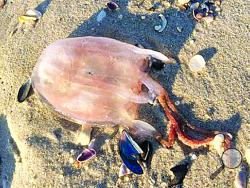Dangerous jellyfish washes up on Jersey shore
Posted: April 5, 2015 - 4:00am
BAY HEAD, N.J. (AP) -- Box jellyfish spark fear among swimmers and deliver nasty stings.
Now Montclair State University scientists have confirmed that a dangerous box jellyfish washed up on the beach in Bay Head last fall.
"I'm a bit surprised about this," Jack Gaynor, an associate professor of biology at the school, told the Asbury Park Press (http://on.app.com/1DKacSj). "This is kind of a nasty jelly and if this is in our area now, that's a problem."
Stinging sea nettle jellyfish in the Barnegat Bay area won't put anyone in the hospital, but "this is a much more serious jellyfish, this box jelly," Gaynor said. "I'm kind of hoping this will not be a recurrence in New Jersey, but we'll see."
Gaynor said the results of DNA analysis on the beached jellyfish confirmed that it's a box jelly. He's convinced that it's a Tamoya -- likely Tamoya haplonema. Researchers will repeat the analysis at least a few times and "I'll know a little bit better about the species in a week," he said.
Tamoya haplonema stings result in burning pain, swelling skin, blisters and scarring, according to a scientific article on jellyfish stings.
Exceedingly rare sightings of box jellyfish in New Jersey waters last fall excited jellyfish experts, who said the venomous animals could reappear when the water warms this year. Shore residents spotted about a half-dozen box jellyfish on ocean beaches in northern Ocean County and one in the Manasquan River last year.
Box jellyfish -- named for their boxy shapes -- have tentacles loaded with venom. They live in warm coastal waters worldwide. Experts think the Gulf Stream may have carried them north to this area, and a storm or winds may have pushed them into the Jersey Shore.
Gaynor said the initial results of DNA analysis showed an approximately 93 or 94 percent match with the genus Tamoya.
"I'm confident that what we've got right now is right and correct and the best I could say right now is that it's the genus Tamoya, which fits with everything else we've seen," he said.
The fact that there wasn't a 100-percent match "could suggest that this is something someone hasn't seen before, maybe slightly different than this other organism," he said.
Gaynor, who lives in South Plainfield, has a summer house in Brick and swims at the Shore.
"I guess when I go swimming now in the ocean, I'm going to be checking around a little bit," he said. "I usually don't feel unsafe in the water but like I said, I'm hoping this is just a fluke and they don't come back and we'll see."

